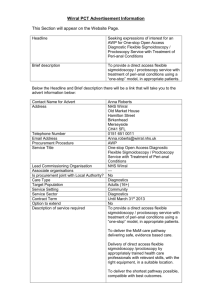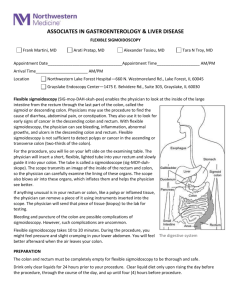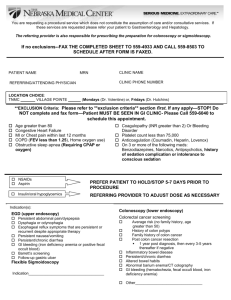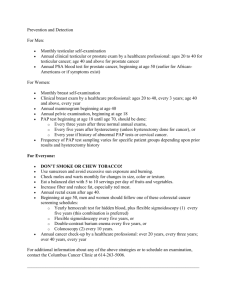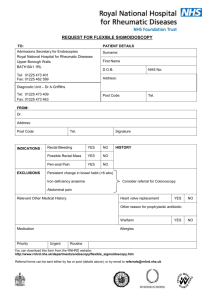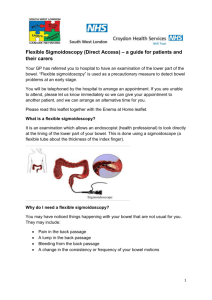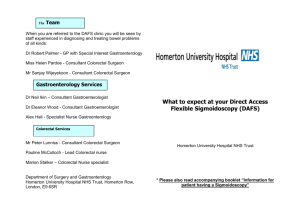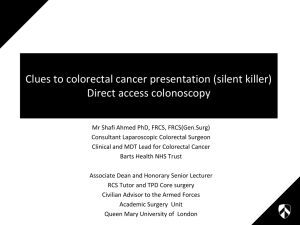Word 2003 - Northern Ireland Cancer Network
advertisement
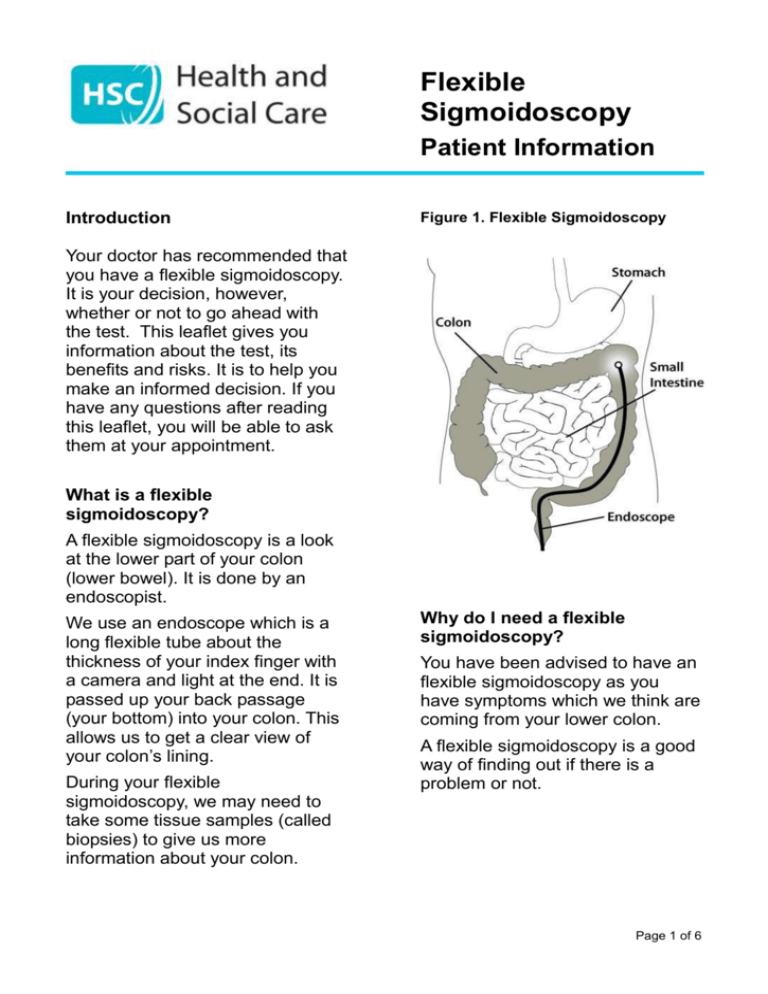
Flexible Sigmoidoscopy Patient Information Introduction Figure 1. Flexible Sigmoidoscopy Your doctor has recommended that you have a flexible sigmoidoscopy. It is your decision, however, whether or not to go ahead with the test. This leaflet gives you information about the test, its benefits and risks. It is to help you make an informed decision. If you have any questions after reading this leaflet, you will be able to ask them at your appointment. What is a flexible sigmoidoscopy? A flexible sigmoidoscopy is a look at the lower part of your colon (lower bowel). It is done by an endoscopist. We use an endoscope which is a long flexible tube about the thickness of your index finger with a camera and light at the end. It is passed up your back passage (your bottom) into your colon. This allows us to get a clear view of your colon’s lining. During your flexible sigmoidoscopy, we may need to take some tissue samples (called biopsies) to give us more information about your colon. Why do I need a flexible sigmoidoscopy? You have been advised to have an flexible sigmoidoscopy as you have symptoms which we think are coming from your lower colon. A flexible sigmoidoscopy is a good way of finding out if there is a problem or not. Page 1 of 6 What happens during a flexible sigmoidoscopy? We may offer you a sedative to help you to relax, although this is very rarely needed. We gently pass the endoscope into your back passage and into your colon. We look at your colon lining on a screen. Air is passed through the endoscope to give a clear view. This may cause some discomfort but will not last long. You may also feel like you need to go to the toilet or to pass wind. This is normal. Try not to be embarrassed as we expect it to happen. We monitor your breathing, pulse and blood pressure throughout. If we take tissue samples (biopsies), these will be sent to the laboratory (lab). If we find polyps, we may be able to remove them. Polyps are small lumps of tissue which hang from the inside lining of the colon. Removing polyps is done by an instrument that is attached to the endoscope. The polyps would also be sent to the lab for testing. At the end of the test, the endoscope is gently removed. The test usually takes 10 - 15 minutes. You should however allow at least two hours for the whole appointment - to prepare, for the test itself, and to recover. Before you leave, we will explain your results and what happens next. We will send similar information to your GP/consultant. Are there any side-effects or possible complications (risks)? Most flexible sigmoidoscopies are done without any problem. The benefit from this test needs to be weighed up against the small risk of complications. Occasionally, the endoscope may damage the colon. You would need to be admitted to hospital for treatment if this happens. Heavy bleeding happens in around 1 in 150 patients. If you are taking medication to thin your blood, you should tell the staff (see next page). Perforation (making a hole in the colon) can happen but is extremely rare. If you have a sedative, you may feel tired or sleepy for several hours. Risks from sedation are different for each person and they depend on the type of drug that is used. Serious complications are rare. The sedative can affect your breathing making it slower, more shallow and possibly stopping it altogether. The sedative may occasionally cause problems with blood pressure. Some people have an allergic reaction although this is very rare. We can usually identify and treat any such problems quickly if they occur. If you are worried about possible risks, ask at your appointment. In some cases, we are unable to complete the test, and may need to ask you to have another one or to have a different test. Page 2 of 6 Is there an alternative? How do I prepare? (continued) Yes. One alternative would be to have a Barium Enema. Another alternative is a scan called a CT Colonography. Not all hospitals offer this. For both of these, if we find polyps you would still need to have a flexible sigmoidoscopy to remove them. Your consultant can discuss this with you if you wish. I have decided to proceed with a flexible sigmoidoscopy. How do I prepare? It is important to read and follow these instructions carefully. Your colon needs to be empty so that we can get a clear view. We will give you bowel preparation or an enema to clear out your lower bowel. Bowel preparation is a drink which makes you empty your bowel. It will make you have diarrhoea. An enema means putting special liquid into your bottom to flush it out. If you have been asked to take bowel preparation you must follow the instructions so we can carry out your test. If you are having sedation, arrange for someone to take you home and stay with you overnight. If you normally take heart or anticonvulsant medication please take it as usual. If you are on iron tablets or bulking agents (Fybogel/Regulan) stop taking them five days before your appointment. Contact us for advice if you are diabetic or are taking Aspirin, Warfarin, or Plavix (clopidogrel). Bring a list of your medications and dosages with you. You may wish to bring a dressing gown and slippers. Leave all valuables at home. Page 3 of 6 What happens when I arrive? Delays to your appointment You will be met by a nurse who will ask you some questions. If you are having a sedative, the nurse will ask about your arrangements for getting home. We also deal with emergencies. These can take priority over your appointment, meaning we may have to ask you to wait or to change your appointment to another day. You will be able to ask the nurse questions if you have any. The nurse will make sure that you understand the flexible sigmoidoscopy. You will have a brief medical assessment. The nurse will take and record your heart rate and blood pressure. If you are diabetic, the nurse will take and record your blood glucose level. If you are happy to proceed with the flexible sigmoidoscopy, you will be asked to sign your consent form if you have not already done so. This unit is a training centre for endoscopy. This means that trainees (supervised by qualified staff) may be involved in your care. If you do not want trainees to carry out your flexible sigmoidoscopy or be present, please inform us when you arrive. Please ask us if you would like information about how we use and store tissue samples and hospital records (including images). Page 4 of 6 What happens after the flexible sigmoidoscopy? You will be allowed to rest in the hospital for as long as you need. If you do not have a sedative, you will be able to go home straight after the test if you wish. After you leave hospital, you should rest for the remainder of the day and limit your activities until 24 hours has passed since your flexible sigmoidoscopy. Ask us for advice if you need it. If you have had sedation you must have someone to stay with you overnight as you will still be drowsy with the sedative. This drowsiness can ‘come and go’. This drowsiness means you must not: Drive a car (or any motorized transport) or ride a bicycle Operate machinery or electrical items Drink alcohol or smoke Take sleeping tablets Sign any legally binding documents or make any important decisions Work at heights (including climbing ladders or onto a chair) Lock the toilet door or make yourself unreachable to the person looking after you Look after children on your own. Aftercare After your flexible sigmoidoscopy, you may feel some discomfort from trapped air. This should settle down within a few hours. To help pass the wind, we suggest, if possible, that you walk around, drink warm drinks or peppermint water, or that you eat some peppermints. You can take pain relief, such as the kind you would take for a headache, as you normally would, and according to their instructions. You can start taking your normal medicines/tablets after your flexible sigmoidoscopy. Please ask if you are unsure if your medicines/tablets will be safe. You can start eating normally again when you feel able. It is likely that your bowel movements will be affected for a few days, but they should return to normal after that. There is some important information on the next page so you know what to do if you have any serious problems. Most people feel back to normal after 24 hours. Page 5 of 6 Aftercare (continued) What if I need to cancel my flexible sigmoidoscopy? Please tell us as soon as possible. If any of the following happen within 48 hours after your flexible sigmoidoscopy, you need to seek help: abdominal/tummy pain that becomes more severe, and is different or more intense than any pains that you would ‘usually’ have breathing difficulties fever (raised temperature) passing a lot of blood from your bottom. If you have had biopsies taken or polyps removed, you could pass a small amount of blood from your bottom. This is normal. If the bleeding becomes more severe, or returns within two weeks of your flexible sigmoidoscopy, you need to seek help. Contact us on the number provided, between 9am – 5pm Monday – Friday. Contact your GP or nearest A&E department outside these hours. Say that you have had a flexible sigmoidoscopy. Publication date: May 2010 Review date: May 2012 Unit contact details About this information This leaflet is provided for general information only and is not a substitute for professional medical advice. Every effort is taken to ensure that this information is accurate and consistent with current knowledge and practice at the time of publication. It was developed using Southern Health & Social Care Trust information by Ms Seanin Ward. It was reviewed and adapted by the Northern Ireland Nurse Endoscopists Group and then approved by the regional Modernising Endoscopy Services project team. Complication rates were accessed in ‘Complications of gastrointestinal endoscopy,’ British Society of Gastroenterology (http://www.bsg.org.uk/ images/stories/docs/clinical/guidelines/e ndoscopy/complications.pdf accessed 27/01/2010) where cardio-pulmonary and sedation-related complications are discussed in detail. If you feel we should include some other information in this leaflet, please tell us so we can consider it when we next update the leaflet. This leaflet can be made available on request in alternative formats and in other languages to meet the needs of those who are not fluent in English. Page 6 of 6
